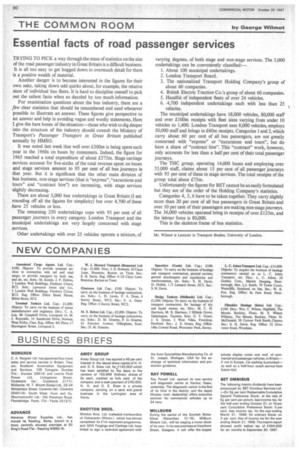Essential facts of road passenger services
Page 92

If you've noticed an error in this article please click here to report it so we can fix it.
TRYING TO PICK a way through the mass of statistics on the size of the road passenger industry in Great Britain is a difficult business. It is all too easy to get bogged down in overmuch detail for there is a positive wealth of material.
Another danger is to become interested in the figures for their own sake, taking down odd quirks about, for example, the relative sizes of individual bus fleets. It is hard to discipline oneself to pick out the salient facts when so dazzled by too much information.
For examination questions about the bus industry, there are a few clear statistics that should be remembered and used whenever possible to illustrate an answer. These figures give perspective to an answer and help in avoiding vague and woolly statements. Here I give the bare bones of the situation—those who wish to dig deeper into the structure of the industry should consult the Ministry of Transport's Passenger Transport in Great Britain published annually by HMSO.
It was noted last week that well over £300m is being spent each year in the 1960s on buses by consumers. Indeed, the figure for 1965 reached a total expenditure of about £375m. Stage carriage services account for five-sixths of the total revenue spent on buses and stage services amount to 95 per cent of all bus journeys in that year. But it is significant that the other main division of bus business, non-stage services (that is "express", "excursions and tours" and "contract hire") are increasing, with stage services slightly decreasing.
There are about 5,000 bus undertakings in Great Britain (I am rounding off all the figures for simplicity) but over 4,700 of these have 25 vehicles or less.
The remaining 250 undertakings cope with 95 per cent of all passenger journeys in every category. London Transport and the municipal undertakings are very largely concerned with stage services.
Other undertakings with over 25 vehicles operate a mixture, of varying degrees, of both stage and non-stage services. The 5,000 undertakings can be conveniently classified:— I. About 100 municipal undertakings.
2. London Transport Board.
3. The nationalized Transport Holding Company's group of about 60 companies.
4. British Electric Traction Co.'s group of about 60 companies.
5. Handful of independent fleets of over 24 vehicles.
6. 4,700 independent undertakings each with less than 25 vehicles.
The municipal undertakings have 18,000 vehicles, 80,000 staff and over £100m receipts with fleet sizes varying from under 10 vehicles to 1,400. London Transport uses 8,000 vehicles, employs 50,000 staff and brings in £60m receipts. Categories 1 and 2, which carry about 60 per cent of all bus passengers, are not greatly concerned with "express" or "excursions and tours", but do haye a share of "contract hire". This "contract" work, however, only accounts for less than a half per cent of their total passenger journeys.
The THC group, operating 14,000 buses and employing over 55,000 staff, claims about 15 per cent of all passenger journeys with 95 per cent of these in stage services. The total receipts of the group total about £75m.
Unfortunately the figures for BET cannot be so easily formulated but they are of the order of the Holding Company's statistics.
Categories 4, 5, 6 have to be taken together. They carry slightly more than 20 per cent of all bus passengers in Great Britain and over 10 per cent of their passengers are making non-stage journeys. The 36,000 vehicles operated bring in receipts of over £125m, and the labour force is 80,000.
This is the skeleton frame of bus statistics.
Mr. Wilmot is Lecturer in Transport Studies, University of London.








































































































































